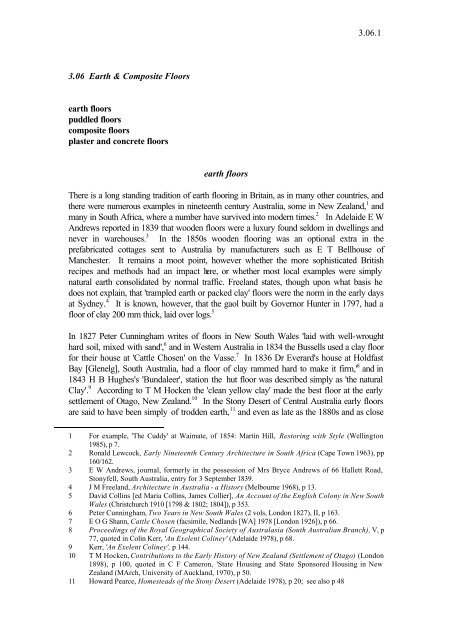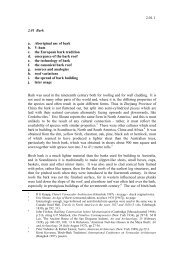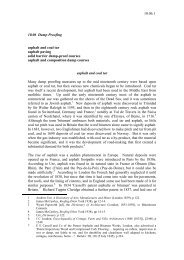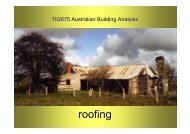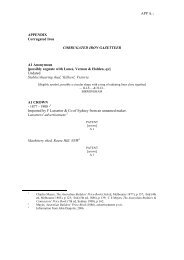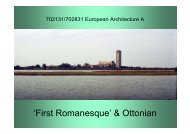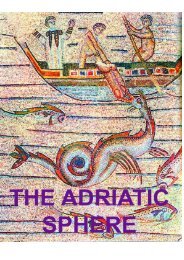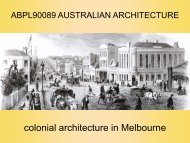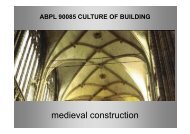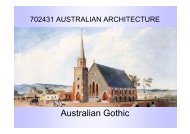3.6 Earth and Composite Floors - Miles Lewis
3.6 Earth and Composite Floors - Miles Lewis
3.6 Earth and Composite Floors - Miles Lewis
You also want an ePaper? Increase the reach of your titles
YUMPU automatically turns print PDFs into web optimized ePapers that Google loves.
3.06 <strong>Earth</strong> & <strong>Composite</strong> <strong>Floors</strong><br />
earth floors<br />
puddled floors<br />
composite floors<br />
plaster <strong>and</strong> concrete floors<br />
earth floors<br />
3.06.1<br />
There is a long st<strong>and</strong>ing tradition of earth flooring in Britain, as in many other countries, <strong>and</strong><br />
there were numerous examples in nineteenth century Australia, some in New Zeal<strong>and</strong>, 1 <strong>and</strong><br />
many in South Africa, where a number have survived into modern times. 2 In Adelaide E W<br />
Andrews reported in 1839 that wooden floors were a luxury found seldom in dwellings <strong>and</strong><br />
never in warehouses. 3 In the 1850s wooden flooring was an optional extra in the<br />
prefabricated cottages sent to Australia by manufacturers such as E T Bellhouse of<br />
Manchester. It remains a moot point, however whether the more sophisticated British<br />
recipes <strong>and</strong> methods had an impact here, or whether most local examples were simply<br />
natural earth consolidated by normal traffic. Freel<strong>and</strong> states, though upon what basis he<br />
does not explain, that 'trampled earth or packed clay' floors were the norm in the early days<br />
at Sydney. 4 It is known, however, that the gaol built by Governor Hunter in 1797, had a<br />
floor of clay 200 mm thick, laid over logs. 5<br />
In 1827 Peter Cunningham writes of floors in New South Wales 'laid with well-wrought<br />
hard soil, mixed with s<strong>and</strong>', 6 <strong>and</strong> in Western Australia in 1834 the Bussells used a clay floor<br />
for their house at 'Cattle Chosen' on the Vasse. 7 In 1836 Dr Everard's house at Holdfast<br />
Bay [Glenelg], South Australia, had a floor of clay rammed hard to make it firm,' 8 <strong>and</strong> in<br />
1843 H B Hughes's 'Bundaleer', station the hut floor was described simply as 'the natural<br />
Clay'. 9 According to T M Hocken the 'clean yellow clay' made the best floor at the early<br />
settlement of Otago, New Zeal<strong>and</strong>. 10 In the Stony Desert of Central Australia early floors<br />
are said to have been simply of trodden earth, 11 <strong>and</strong> even as late as the 1880s <strong>and</strong> as close<br />
1 For example, 'The Cuddy' at Waimate, of 1854: Martin Hill, Restoring with Style (Wellington<br />
1985), p 7.<br />
2 Ronald Lewcock, Early Nineteenth Century Architecture in South Africa (Cape Town 1963), pp<br />
160/162.<br />
3 E W Andrews, journal, formerly in the possession of Mrs Bryce Andrews of 66 Hallett Road,<br />
Stonyfell, South Australia, entry for 3 September 1839.<br />
4 J M Freel<strong>and</strong>, Architecture in Australia - a History (Melbourne 1968), p 13.<br />
5 David Collins [ed Maria Collins, James Collier], An Account of the English Colony in New South<br />
Wales (Christchurch 1910 [1798 & 1802; 1804]), p 353.<br />
6 Peter Cunningham, Two Years in New South Wales (2 vols, London 1827), II, p 163.<br />
7 E O G Shann, Cattle Chosen (facsimile, Nedl<strong>and</strong>s [WA] 1978 [London 1926]), p 66.<br />
8 Proceedings of the Royal Geographical Society of Australasia (South Australian Branch), V, p<br />
77, quoted in Colin Kerr, 'An Exelent Coliney' (Adelaide 1978), p 68.<br />
9 Kerr, 'An Exelent Coliney', p 144.<br />
10 T M Hocken, Contributions to the Early History of New Zeal<strong>and</strong> (Settlement of Otago) (London<br />
1898), p 100, quoted in C F Cameron, 'State Housing <strong>and</strong> State Sponsored Housing in New<br />
Zeal<strong>and</strong> (MArch, University of Auckl<strong>and</strong>, 1970), p 50.<br />
11 Howard Pearce, Homesteads of the Stony Desert (Adelaide 1978), p 20; see also p 48
3.06 <strong>Earth</strong> <strong>and</strong> Stone: <strong>Earth</strong> & <strong>Composite</strong> <strong>Floors</strong>: 99 3.06.2<br />
to civilisation as Pitt Town, on the Hawkesbury, a beaten earth floor appears. 12 At about<br />
this time, also, a 'clay floor' was laid to the ver<strong>and</strong>ah of 'Til Til' station in the Riverina. 13<br />
It was a common practice water these floors at regular intervals, to help them consolidate.<br />
E S Sorensen spoke of the floor of a typical settler’s house being either of slabs or of earth,<br />
the latter requiring 'frequent watering to keep it firm.' 14 Fairly comprehensive instructions for<br />
flooring a tent in earth were given by 'Rusticus' in 1855: 15<br />
The floor may ...be raised a little above the level of the ground outside, <strong>and</strong> a strip of<br />
broad paling placed all round to keep it in. It may then be covered with a coating of<br />
small broken stone, earth <strong>and</strong> wood ashes, which, if occasionally sprinkled with<br />
water, becomes, in the course of a short time, almost as hard <strong>and</strong> complete as stone.<br />
But other types of floors were sometimes watered simply to relieve the heat 16 (or, we may<br />
surmise, to lay the dust), so the practice of watering alone is not a clear indication that the<br />
floor is earthen.<br />
A beaten earth floor might be finished with a layer of yellow ochre, as at 'Dalry' in the Yarra<br />
Valley in the 1850s. 17 The best earth floor of course was antbed. When it was first used is<br />
unclear, but J G Knight referred to it in the Northern Territory in 1880: 18<br />
A fair substitute for lime mortar is found in the earth of which the anthills are formed,<br />
the ant producing a glutinous substance to bind the earthy particles together. This<br />
material, when moistened <strong>and</strong> beaten up, makes an excellent floor, <strong>and</strong> answers for<br />
bedding brick or stone.<br />
By 1889, when Constance Ellis came across it in Queensl<strong>and</strong>, antbed was well enough<br />
established to call for little comment. 19<br />
puddled floors<br />
Puddled earth is, after simple trampled ground, perhaps the basic form of earth flooring<br />
likely to have been used in Australia, <strong>and</strong> a description of its use in Engl<strong>and</strong> survives from<br />
1641. The earth was broken down into a fairly fine consistency, thoroughly watered, left to<br />
lie for two weeks, then beaten with flat pieces of wood. 20 In 1841 Robert <strong>and</strong> Eliza<br />
12 R I Jack, Exploring the Hawkesbury (Kenthurst, NSW, 1990 [1986]), p 64.<br />
13 Peter Freeman The Homestead: a Riverina Anthology (Melbourne 1982), p 170, quoting the Til<br />
Til station diary for 26 July 1887.<br />
14 E S Sorensen, Life in the Australian Backblocks (London 1911), p 25.<br />
15 'Rusticus' [W S Chauncy], How to Settle in Victoria (Melbourne 1855), p 23.<br />
16 The Scotts, of Glendon, did this in accordance with the Indian practice with which they were<br />
familiar. James Broadbent, 'Aspects of Domestic Architecture in New South Wales 1788-1843' (3<br />
vols, PhD, Australian National University, 1985), II, p 472.<br />
17 Hubert de Castella [ed C B Thornton-Smith], Australian Squatters [Les Squatters Australiens]<br />
(Melbourne 1987 [1861]), p 106.<br />
18 J G Knight, The Northern Territory of South Australia (Adelaide 1880), p 27.<br />
19 C J Ellis, I Seek Adventure (Sydney 1981), p 5.<br />
20 C F Innocent, The Development of English Building Construction (Cambridge 1916), p 158,<br />
quoting Henry Best's Farming Book, as published by the Surtees Society, p 107.
3.06 <strong>Earth</strong> <strong>and</strong> Stone: <strong>Earth</strong> & <strong>Composite</strong> <strong>Floors</strong>: 99 3.06.3<br />
Pohlman made a puddled floor at their 'Glenhope' station in the Port Phillip District<br />
[Victoria] reportedly by ramming down wet pulverised clay, covering the black soil upon<br />
which the house was built. 21 In later Victoria puddle of an essentially similar description was<br />
used for waterproofing dams <strong>and</strong>, with less elaborate preparations, for purposes where it<br />
was not required to be waterproof. Clay was dug from the ground, chopped up <strong>and</strong> mixed<br />
with water, tempered, tipped into place, <strong>and</strong> thoroughly trodden. If it was really well<br />
prepared it became similar to brick earth when ready for moulding. 22 At 'May Downs',<br />
inl<strong>and</strong> from Rockhampton, Arthur Mackenzie used puddled antbed: this was apparently in<br />
the 1850s, which would make this the earliest reference to the material in Australia. 23<br />
In a specification for terrace houses in the Melbourne suburb of Elwood in 1854, there was<br />
to be nine inches [230 mm] wide of puddling on the outside of the cellar walls, done as the<br />
wall rose, 'to be well punned in twelve inches [300 mm] courses <strong>and</strong> no s<strong>and</strong> to be allowed<br />
to get among the clay'. For the cellar floor the builder was directed to 'Puddle the whole ...<br />
with clay well <strong>and</strong> evenly punned to the thickness of six inches [150 mm] over which spread<br />
a layer of s<strong>and</strong> two inches [50 mm] deep.' 24<br />
composite floors<br />
At 'Merton' in the Hunter Valley, the floor of William Ogilvie's house in 1824 was of<br />
pipeclay mixed with powdered earth, 25 but Ellen Ogilvie found it 'very troublesome to keep<br />
clean', <strong>and</strong> it was overlaid with timber a few years later. 26 It seems probable that pipeclay<br />
<strong>and</strong> lime were both used in the floor of G C Hawker's homestead at 'Bungaree', South<br />
Australia, in 1842, for his diary records on 28 February that he brought in a load of<br />
pipeclay, the following day that he obtained a load of lime, <strong>and</strong> four days after that<br />
'plaistered the floor of my room'. 27 For his house at Hahndorf, South Australia, in 1895,<br />
Edmund Diderich used clay for the main floor, but in the kitchen he added lime for extra<br />
strength. 28 At Palmerston [Darwin] in 1870 the government resident, Lieutenant Blomfield<br />
Douglas, had a hut with a floor 'made of mud, pressed flat, <strong>and</strong> mixed with gravel, s<strong>and</strong> <strong>and</strong><br />
limestone, well rolled till a smooth surface was obtained.' 29<br />
More elaborate Australian floors presumably derived from the English tradition of using lime,<br />
ash <strong>and</strong> other materials, for which there were countless recipes. Such floors - to synthesise<br />
from a number of sources - might in Engl<strong>and</strong> contain any of the following ingredients in<br />
various proportions: loam, s<strong>and</strong>, quicklime, slaked lime, brick dust, gun dust, anvil dust<br />
from a forge, cupola ash, coal ash, oil, stale milk, bullock's blood, <strong>and</strong> yellow ochre. The<br />
21 J O R<strong>and</strong>ell, Pastoral Settlement in Northern Victoria - Volume II (Burwood [Victoria] 1982), p<br />
124.<br />
22 C B Mayes, Australian Builders' Price-Book (Melbourne 1862), p 9.<br />
23 Judith Wright, The Generations of Men(Melbourne 1959), p 15.<br />
24 Russell, Watts & Pritchard, 'Specification for ... dwelling houses ... at Elwood ... for Joseph<br />
Docker', 13 Decemb er 1854,. Manuscripts Collection, State Library of Victoria, pp 1-2..<br />
25 George Farwell, Squatter's Castle (Melbourne 1973), p 54<br />
26 Farwell, Squatter's Castle, p 95.<br />
27 Colin Kerr, 'An Exelent Coliney' (Adelaide 1978), p 133.<br />
28 R J Noye, 'The Old Bush Hut', South Australiana ,VI (1967), p 16, quoted in Terence Lane &<br />
Jessie Serle, Australians at Home (Melbourne 1994), p 324.<br />
29 Harriet Daly, Digging, Squatting, <strong>and</strong> Pioneering Life in the Northern Territory of South<br />
Australia (London 1887), p 51.
3.06 <strong>Earth</strong> <strong>and</strong> Stone: <strong>Earth</strong> & <strong>Composite</strong> <strong>Floors</strong>: 99 3.06.4<br />
ingredients would generally be sifted together, tempered with water, allowed to st<strong>and</strong> for<br />
some days, <strong>and</strong> tempered again. They might be laid over a base of well consolidated<br />
gravel, brickbats or lime core; placed in a 60 to 80 mm thickness; rolled, trodden, beaten<br />
or rammed, sometimes at daily intervals for as long as two weeks; possibly screeded with 6<br />
to 13 mm of stone lime mixed with egg white, <strong>and</strong>/or possibly rubbed with oil, or with a<br />
coarse woollen cloth. 30 In South Africa also, an area known to many Australian settlers,<br />
flooring made of clay, manure, ox blood <strong>and</strong> lime, 31 or of clay, fat <strong>and</strong> cow dung was in use<br />
up to the 1840s.<br />
Loudon describes the formation of a 'sound, warm, <strong>and</strong> durable floor' as follows: 32<br />
... the ground being well drained, <strong>and</strong> covered to a depth of a foot [300 mm] with<br />
loose stones, lay on these a stratum of a mixture of gravel <strong>and</strong> newly slacked lime, to<br />
the depth of six inches [150 mm]; let this be well beaten, <strong>and</strong> brought to a perfect<br />
level, <strong>and</strong> after it has dried a week or a fortnight, according to the weather, cover it,<br />
to the depth of two inches [150 mm], with a composition of equal parts of quicklime<br />
<strong>and</strong> powdered smithy ashes, brought to the consistency of mortar by the addition of<br />
bullock's blood, stale milk, oil, or any other description of greasy matter. As soon as<br />
this is laid on, it must be well beaten with the back of a spade, or rolled with a castiron<br />
roller; after which, if immediately well <strong>and</strong> long rubbed with coarse woollen<br />
cloths, it may be brought to a high polish. The colour, when bullock's blood is used,<br />
is at first brown, but after some weeks it changes to a light grey. When yellow ochre<br />
is added to the mixture, a Bath stone colour is produced.<br />
C B Allen’s Cottage Building is one English source which would have been widely known<br />
in Australia, <strong>and</strong> it describes lime-ash floors. A recommended version is to mix washed<br />
s<strong>and</strong> <strong>and</strong> lime ashes in a ratio of 2 to 1. After two or three days this mixture would be<br />
tempered with hot water, then laid in place to a depth of 80 mm. After a further two or<br />
three days it would be hard enough to tread on, <strong>and</strong> it should now be beaten all over with a<br />
wooden mallet to make it completely hard, using a trowel <strong>and</strong> a little water to keep it<br />
smooth. 33 Another work known in Australia, <strong>and</strong> indeed specifically designed for the use of<br />
settlers, was R S Burn's Colonist's <strong>and</strong> Emigrant's H<strong>and</strong>book of the Mechanical Arts, of<br />
1854. Burn quotes Henry Roberts's recipe, which was for a mixture of s<strong>and</strong> <strong>and</strong> lime-ash in<br />
the same proportions <strong>and</strong> laid in the same thickness, but with the differences that the original<br />
mixture was left a fortnight while the lime slaked, before it was tempered <strong>and</strong> laid, <strong>and</strong> that it<br />
was suggested that the finished floor be rubbed twice over with linseed oil, to give it the<br />
appearance of stone. It should be laid on a six inch [150 mm] substratum of well beaten<br />
30 G S Howard et al, The New Royal Encyclopaedia Londinensis (London, in parts from c 1785), sv<br />
Floor; William Marshall, Rural Economy or Yorkshire, quoted by Innocent, op cit, p 160;<br />
Thomas Rudge, General View of the Agriculture of the County of Gloucester (London 1807), pp<br />
245-6; Builder, VII, 309 (6 January 1849), p 6; 310 (13 January 1849), p 20; 311 (20 January 1849),<br />
p 29; Henry Roberts, The Dwellings of the Labouring Classes (London 1850), pp 26-7.<br />
31 Lewcock, Early Nineteenth Century Architecture in South Africa, p 160.<br />
32 J C Loudon, An Encyclopædia of Cottage, Farm, <strong>and</strong> Villa Architecture <strong>and</strong> Furniture (London<br />
1846 [1833]), §585, p 288.<br />
33 C B Allen, Rudimentary Treatise on Cottage Building (2nd ed, London 1854 [1849-50]), p 40.
3.06 <strong>Earth</strong> <strong>and</strong> Stone: <strong>Earth</strong> & <strong>Composite</strong> <strong>Floors</strong>: 99 3.06.5<br />
coarse gravel, brickbats <strong>and</strong> lime core, well beaten, <strong>and</strong> with tar added if the situation was<br />
damp. 34<br />
Rarely, apart from Cunningham's description of a soil <strong>and</strong> s<strong>and</strong> mixture, do we find any<br />
indication of precisely what earth was used in Australian floors <strong>and</strong> how it was treated.<br />
John McKimmie of Bundoora, Victoria, spoke of the use of clay mixed with cow dung.<br />
The most informative description is in Tucker's Ralph Rashleigh, of the floor of a hut on the<br />
Hawkesbury in the early 1820s, 'made of cow dung <strong>and</strong> ashes trod into a solid <strong>and</strong> firm<br />
mass, but ... level <strong>and</strong> clean-swept'. 35 The cow dung, <strong>and</strong> apparently the ashes ['fire'] are<br />
referred to in the verse: 36<br />
The old h<strong>and</strong>s told me how to build a clean dirt floor:<br />
Beat it hard with spades <strong>and</strong> tread of feet,<br />
Then soak with green cow dung <strong>and</strong> sweep again.<br />
Now sprinkle water, fire, <strong>and</strong> clear creek s<strong>and</strong>,<br />
And sometimes strew with cool green leaves;<br />
Sprinkle <strong>and</strong> sweep it twice a day<br />
Until, clean <strong>and</strong> sweet <strong>and</strong> hard,<br />
It gleams, black, polished like a board.<br />
In Western Australia the Rev J R Wollaston, in 1848, considered himself fortunate to have<br />
met up with a man familiar with the West Indian method, in which a lime floor was 'trodden<br />
<strong>and</strong> rammed, then repeatedly worked <strong>and</strong> smoothed with sugar water' to produce an<br />
excellent floor. 37 In the Windorah area of western Queensl<strong>and</strong>, where tallow was also used<br />
in the walls, the floors were of 'ashes <strong>and</strong> tallow, which set like cement'. 38 Also in western<br />
Queensl<strong>and</strong> the local 'kopi' or infusorial earth, resembling gypsum, was used as flooring in<br />
'Rosebank' homestead, <strong>and</strong> in the same region it was used with limestone in the foundations<br />
of 'Cacouri' homestead. 39 For a proposed court house in Birdsville the local police<br />
magistrate recommended in 1888: 40<br />
For the ver<strong>and</strong>ah floors I think good puddled clay mixed with a certain proportion of<br />
s<strong>and</strong>, lime <strong>and</strong> manure would be cheapest <strong>and</strong> most enduring as the sun would cause<br />
flooring boards to warp <strong>and</strong> bend in all directions ...<br />
plaster <strong>and</strong> concrete floors<br />
34 R S Burn, The Colonist’s <strong>and</strong> Emigrant’s H<strong>and</strong>book of the Mechanical Arts (Edinburgh 1854), p<br />
42.<br />
35 James Tucker, The Adventures of Ralph Rashleigh: in the Hawkesbury area, earth floor of Mick's<br />
hut: quoted Philip Cox & J M Freel<strong>and</strong>, Rude Timber Buildings of Australia (London 1969), p 46,<br />
n 12.<br />
36 From 'Beaufoy Merlin', by Lindsay Gordon [apparently a modern poet, not A L Gordon], quoted<br />
in Eve Pownall, Mary of Maranoa (2nd ed, Sydney 1959 [1959]), p 62.<br />
37 J R Wollaston [ed C A Burton & H U Penn], Wollaston's Albany Journals (1848-1856) (Perth<br />
1954), p 65.<br />
38 E S Sorensen, Life in the Australian Backblocks (London 1911), p 25.<br />
39 Janet Hogan, Building Queensl<strong>and</strong>'s Heritage (Richmond [Victoria] 1978), pp 101, 103.<br />
40 Donald Watson, The Queensl<strong>and</strong> House [typescript report] (Brisbane 1981), p 8.8.
3.06 <strong>Earth</strong> <strong>and</strong> Stone: <strong>Earth</strong> & <strong>Composite</strong> <strong>Floors</strong>: 99 3.06.6<br />
Another English type of relevance to Australian practice was the plaster floor. In Engl<strong>and</strong> it<br />
was used especially in the upper storeys of houses, <strong>and</strong> was valued for its soundproofing<br />
<strong>and</strong> fireproofing qualities. Around Nottingham 'a thick layer of coarse gauged stuff' was<br />
placed over reeds, 41 <strong>and</strong> in Leicestershire many upper floors consisted of 50 to 75 mm of<br />
well tempered lime plaster over reeds. 42 In the Cotswolds the joists were of timber in the<br />
round, <strong>and</strong> the space between was spanned with interlacing hazel sticks, on top of which<br />
was a mixture of clay <strong>and</strong> chopped straw. This was finished with either a smooth cement<br />
face or a layer of oak boarding, while the ceiling below was plastered. 43 C B Allen, in his<br />
Cottage Building, described the use of reeds, rather as in Nottinghamshire <strong>and</strong><br />
Leicestershire, but suggested that strips of hoop iron would be better. 44 In Australia there is<br />
no suggestion that upper floor levels were constructed like this (though the use of Dutch<br />
biscuits, discussed below, is somewhat similar), but Mayes's Australian Builder's Price-<br />
Book of 1862 lists two types of plaster screed, as well as one of Portl<strong>and</strong> cement, suitable<br />
for laying on top of what he calls concrete. The first type was a trowelled stucco of lime<br />
<strong>and</strong> hair, <strong>and</strong> the second was a three to one mixture of Keene's cement (a hard plaster). 45<br />
When Mayes refers to 'concrete' as the base for a plaster floor he of course does not mean<br />
a reinforced concrete slab, such as one might use today, but a primitive material which itself<br />
would be not be far removed from traditional English types, such as lime-ash flooring.<br />
Joseph Elliott, in Adelaide, had just such a floor of 'what is called concrete, being a<br />
composition of three parts s<strong>and</strong> <strong>and</strong> one part of lime, which when properly set becomes as<br />
hard as a rock'. 46 In Engl<strong>and</strong> C B Allen recommended a concrete of gravel, s<strong>and</strong>, lime <strong>and</strong><br />
tar, <strong>and</strong> on top of this a 40 mm screed of good cement. 47 This approaches the character of<br />
asphalt (which will be discussed separately below), <strong>and</strong> something similar was used in Natal<br />
- 'well washed gravel, lime <strong>and</strong> hot gas tar ... in such proportions as will render a black<br />
mortar. 48 It is clear that there is every gradation between the naked earth <strong>and</strong> the true<br />
concrete floor.<br />
A professional plasterer in Engl<strong>and</strong> described how to lay first 'as a hard bottom, clean<br />
gravel, s<strong>and</strong>, lime <strong>and</strong> tar, to form a concrete', a word which he probably used in a similar<br />
sense to Mayes. One should then: 49<br />
lay down an inch <strong>and</strong> a half thickness of good cement, - either Blashfield's No.1 <strong>and</strong><br />
three of coarse s<strong>and</strong>, or Atkinson's cement <strong>and</strong> three of s<strong>and</strong>, or patent Portl<strong>and</strong><br />
cement <strong>and</strong> four of clean coarse s<strong>and</strong>, floated in by a rule on screeds; care being<br />
taken to prevent as much as possible the joints from setting, so that it may be one<br />
sheet. If the cement set slow, while soft trowel it down, but not when it is setting, or it<br />
41 Edward Dobson, The Art of Building (2nd ed, London 1854), p 122.<br />
42 'The Influence of Material on Design in Woodwork' in T R Davison [ed], The Arts Connected<br />
with Building (London 1909) pp 70, 72.<br />
43 E G Dawber, Old Cottages, Farm-Houses <strong>and</strong> other Stone Buildings in the Cotswold District<br />
(London 1905), p 15.<br />
44 C B Allen, Rudimentary Treatise on Cottage Building (2nd ed, London 1854 [1853]), pp 40-41.<br />
45 C B Mayes, Australian Builders' Price-Book (Melbourne 1862), p 75.<br />
46 Joseph Elliott, Our Home in Australia (Sydney 1984), p 60.<br />
47 Allen, Cottage Building, p 40.<br />
48 Brian Kearney, Architecture in Natal (Cape Town 1973), p 66, quoting Davis' Natal Almanac<br />
(1864).<br />
49 Builder, VII, 310 (13 January 1849), p 20.
3.06 <strong>Earth</strong> <strong>and</strong> Stone: <strong>Earth</strong> & <strong>Composite</strong> <strong>Floors</strong>: 99 3.06.7<br />
will injure the face. If set too quick for that, leave it with a rough key, <strong>and</strong> cover to an<br />
eighth inch [3 mm] thick with fine mortar, <strong>and</strong> trowel it gently before it begin to set. If<br />
the floor is not likely to be damp, instead of the gravel, &c., pave it with clean hard<br />
brick-bats, half an inch [13 mm] apart, <strong>and</strong> cover it with one inch [25 mm] of good<br />
cement.<br />
Where such floors survive, which is rare enough, they are almost never documented, <strong>and</strong> it<br />
is impossible to determine their composition by looking at them. One example is the men's<br />
quarters at 'Werribee Park', Victoria, where the floor is taken to date from some time<br />
before 1880, <strong>and</strong> consists of a 12-20 mm screed, which looks like cement <strong>and</strong> is laid over<br />
s<strong>and</strong>. 50<br />
50 Information from John Grinpukel, Melbourne Water, 1992.


